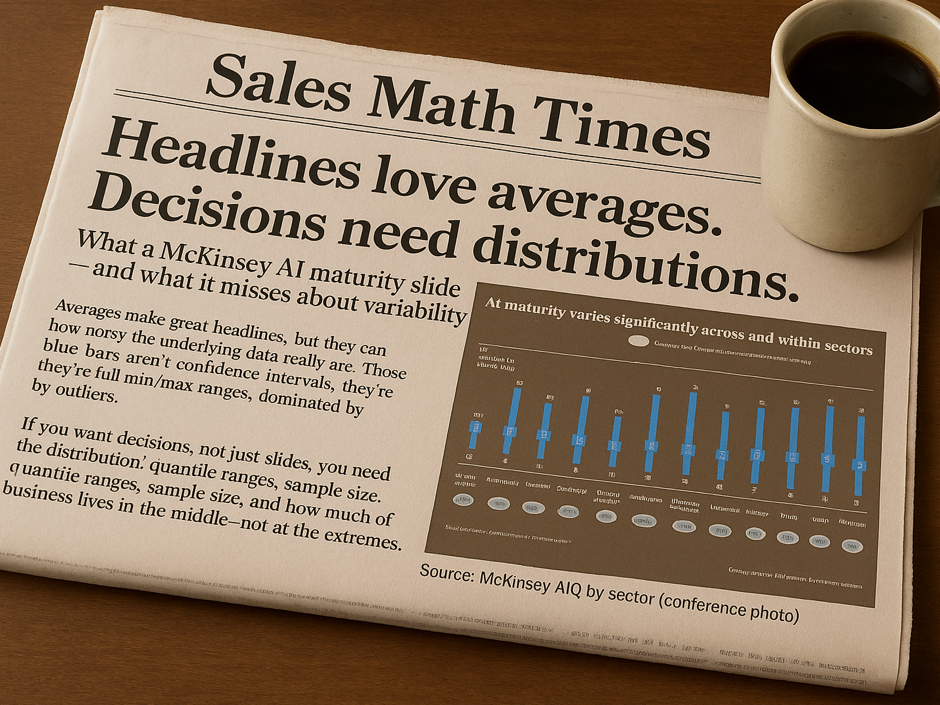Sales Capacity Planning
- Bill Kantor

- Nov 20, 2023
- 3 min read
Updated: Jan 9
Sales capacity planning is the process of determining and optimizing the resources needed to achieve your desired sales targets.
Before setting staffing goals and territory assignments, it is critical to understand your growth constraints. There are three possibilities for businesses with a direct sales model:
Opportunity-processing constrained: Sales understaffed
You are constrained by your ability to process opportunities. Signs you are operating under this condition: Everything superficially looks great. Your sales team is crushing it. Sales and marketing get along. Voluntary sales attrition is very low. Your cost of sales is low. Less than 20% of your gross margin. But—opportunities are going unattended.

Demand-generation constrained: Sales overstaffed
You are constrained by your ability to create new opportunities. Signs you are operating under this condition: Your sales team has a hard time meeting even reasonable quotas. Salespeople are fighting over territory/account assignments. Sales blames marketing for their inability to sell. You have high involuntary attrition. You regularly cut the lowest performers. Your cost of sales is very high. Typically, over 70% of gross margin.
Demand-generation, opportunity-processing balanced: Optimal
Your lead flow and sales team processing capacities are matched. This is what you want. Under these conditions, you will achieve optimal sales productivity. Signs you are operating under these conditions: Your sales team is mostly meeting quota… You get the idea.
For those of you who have never experienced it, there are businesses that are opportunity-processing constrained. It’s a lovely thing. Sales capacity planning is very simple for these companies—provided that there are not any market constraints on growth. Compute your average sales productivity per salesperson. Hire as many salespeople as you can. Assign them each the average sales attainment and let them succeed.
The rest of us need to be more careful about sales resource planning. Average sales productivity per salesperson is not as important because each additional hire may not have enough opportunity flow to keep them busy. And we know it can be better. Assigning quotas is more challenging for these firms.
Capacity planning for these companies starts with understanding how much lead flow you need to support a salesperson. From there, you can have an informed discussion about whether you have the market, resources, and knowhow to create that lead flow. Without that, it is difficult to know how many salespeople or marketing/BDRs to hire.
How do you get a bead on answering this question?
Start with a careful analysis of win rate—measured as a function of time. Add some clever reverse-funnel math to get the daily lead flow needed to meet your plan. Determine your historic range of lead processing productivity. The ratio of required lead flow to median historic lead flow processing capacity is your answer. If that's outside of historic operating limits, you need more sales capacity.
See how to sell more. Try Funnelcast. |
Funnelcast does this for you in minutes.

The process control chart shows the recent capacity[1] for processing new opportunities. In this case, in order to meet a sales goal, the user has speculatively boosted demand generation (the daily gen rate) for the New Business cohort. This could be due to many reasons. For instance, the company could be planning expanded marketing activities or have received a favorable analyst report.
Based on past history, this higher lead flow will require 23 – 31 salespeople ("processors"). The current New Business team staffing (16) would be pushed to 143% of their demonstrated capacity (upper limit). That group will be operating like the "Sales understaffed" situation at the top of this article. The team will need to be expanded. At the same time, salespeople are underutilized in the Add-on team. Like the "Sales overstaffed" situation up top. They have 5 people but only need 4 to handle the current demand generation. If the workload can be reassigned, it would save one hire.
[1] Capacity is one important constraint. But there are others. Notably: market size and knowhow.




Comments